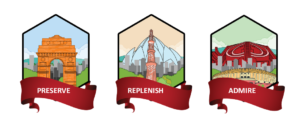“RECOGNISE THE HIDDEN TREASURES OF WISDOM”
Around us, we see buildings, roads, shops and streets that provide a landscape vision. Have we ever thought, what lies underneath?
Since time immemorial, Indian heritage has developed and prospered in several forms. It has a vibrant and diverse past. Sometimes, a question arises as to why we should worry about the conservation of old, outdated buildings and remains of cultural heritage, both tangible and intangible? Our heritage gets demolished and converted into buildings, expressways, highways and schools. We hardly see it with an eye of wonder, marvel and fascination. On the other hand, the rest of the world recognises the value of historic buildings and cultures spanning thousands of years and later incorporating them in a city’s ethos and even economy.
Is it so difficult to appreciate the wonder of our invaluable heritage?
Our heritage is very beautiful and yet quintessential. What we see today is the reflection or mirror of the past. When we see a dance show, we can immediately say the lifestyle of the Indian society is being staged. From saying “Namaste” to doing meditation, all represent our ethos, spirit and personality. As a source of identity, heritage is a valuable factor for empowering local communities and enabling vulnerable groups to participate fully in social and cultural life. It can also provide time-tested solutions for conflict prevention and reconciliation. Our heritage and traditions teach us to inculcate good habits and make us a good human being. It is a beautiful gift from our earlier generations that will help us become a better human being and build a harmonious society.
Our Indian old epics like Ramayana and Mahabharata are examples of love, patience, separation and sacrifice. The story of Rama and his brothers show what love is for each other and for their stepmothers. Also, how easy it is to sacrifice the glitter and luxury of palaces and live in a mere forest. The family values that come from the teacher or Guru (Mehrishi) to values from fatherhood and motherhood on several aspects of life teach us important truths that go beyond existence. The importance of keeping promises in life and abiding them is a clear example in Ramayana. The path of righteousness should be the lighting lamp at the easiest and most difficult times.
Mahabharata teaches us how to live, what to do and what not to do. It gives a background of what humans hold within themselves and the facets they represent. For example there are traits like love, courage, honesty, truth, hatred, cowardice, lies, deceit and foolishness. These are the cycles that human beings went through then and continue to go through even today. Authored thousands of years ago, they hold much relevance in all our lives. Coming to historic tangible marvels, the traditional festivals, music, painting and monuments reflect the glory, and have won admiration from people all across the world. The past is a testimony of valuable assets that India has been glorified for. Our heritage is the reminiscence of the living witnesses of the historic golden era. We have a repository of immeasurable treasures that are to be recognized and applauded in these modern times.
However, it is disheartening to note that our own heritage is neither admitted nor recognized as a valuable treasure, by its own people. The repackaged clones of Indian Heritage when brought back in new wrapping are gobbled as modern fads and many are willing to pay high premiums for the immense value they profess to bring. We seem to lack curiosity, self-confidence and zeal to re-discover and innovate our own heritage.
When we don’t respect and care for our heritage, how can we expect the world to endorse its value?

For example, Yoga and Meditation are in vogue in India, since times immemorial. Yoga is said to be 10,000 years old and it’s mention was engraved in Rigveda. Meditation, which has become a mainstream practice everywhere in the world, originated 8,000 years ago. It finds reference in the Vedas. Many internationally written books talk about different types of meditation and we ultimately gain knowledge from them rather than the actual origin of these practices. Today, our second wave of recognition for these commenced when it came back endorsed by the advanced nations of the world. Another noteworthy observation is that Buddha, who gained enlightenment in BodhGaya, India, and created a path towards Buddhism, is mainstream in many countries outside India, that include even some advanced countries, and yet its principles are not so well visible in its own land of origin.
For India to once again reclaim its yesteryears glory of the golden era, it is important for its people to recognise the richness of our own heritage, and thus preserve various monuments and ancient wisdom. And also, advance those to the next level of progression in consonance to contemporary modern times, for the coming generations to be benefited by the superior accomplishments of our ancestors. We are a part of a grand legacy and we should uphold that responsibility through respect, conservation, and advancement of our great heritage. We owe it to our future generations.
As Mahatma Gandhi said,
“A nation’s culture resides in the hearts and in the soul of its people.”

